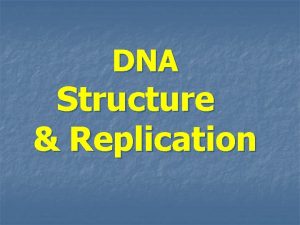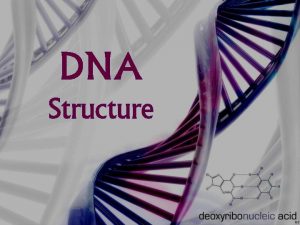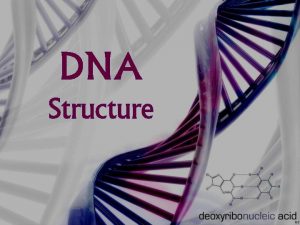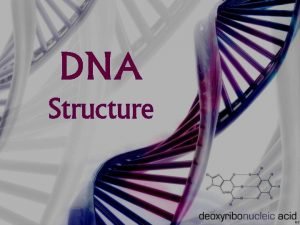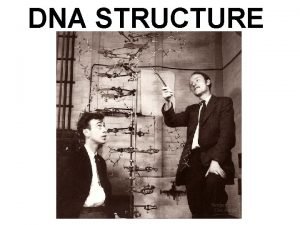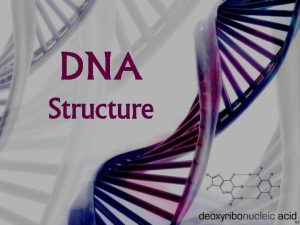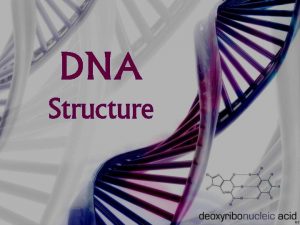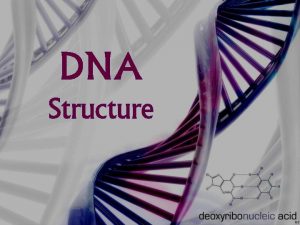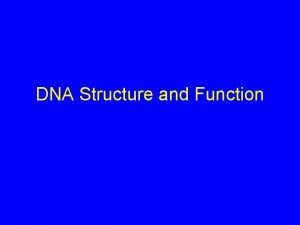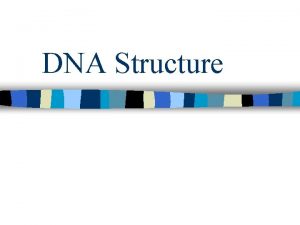The Structure of DNA What is DNA DNA

















- Slides: 17

The Structure of DNA

What is DNA? • DNA (or Deoxyribonucleic Acid) is often called “The blueprint of life”. • DNA, like Proteins, Carbohydrates, and Fats, are biochemical polymers. The monomer is a “nucleotide” • DNA contains all of the instructions to make each organism the DNA is contained in.

The Discovery of the structure of DNA • The structure of DNA was discovered in 1952 by Rosalind Franklin (who showed DNA was a helix using X-rays) and Jim Watson and Francis Crick who built models. • They realized that the structure told us much about how DNA functioned as the genetic material.

Why do we study DNA? DNA • DNA is in ALL living cells, it is centrally important to ALL life on Earth. • It works the same way in all of these organisms. If we understand the principles of function in one organism we can often extrapolate those functions to other organisms. • Understanding how DNA works has, and will continue to have, profound medical implications and tell us much about the history of life on this planet.

DNA, Genes, & Chromosomes • Chromosomes are long strands of DNA (each of ours are on average 200 million nucleotides long). • Individual instructions on the DNA are called genes. • Each gene has instructions to build 1 protein. • Our 20000 genes are contained on our 46 chromosomes (E. coli has 2000 genes and only 1 chromosome) and are passed on when organisms reproduce.

The Shape of the Molecule • DNA is a very long polymer often consisting of millions of nucleotides. • Its basic shape is that of a twisted ladder or a twisted zipper. • The poles of the ladder are the sugar-phosphate backbones and the rungs are the bases • Each pole of the ladder is arranged in the shape of a helix and because the two poles are intertwined with each other it is called a double helix.

One Strand of DNA • The backbone of the molecule is made of alternating molecules of phosphate and deoxyribose sugar • The “rungs of the ladder” are called nitrogenous bases phosphate deoxyribose bases

Nucleotides • One deoxyribose, together with its phosphate and base, make a nucleotide. • Nucleotides are the monomer of DNA O O -P O Nitrogenous base O O C Phosphate C C C O C Deoxyribose

One Strand of DNA • One strand of DNA is a polymer of nucleotides. • One strand of DNA can have many millions of nucleotides within that polymer. A nucleotide monomer.

Four nitrogenous bases DNA has four different bases: C • Thymine - T • Adenine - A • Guanine - G • Cytosine -

Two Kinds of Bases in DNA • Pyrimidines are single ring (Hexagon) bases. N N O C C C N • Purines are double (Hexagon and pentagon) ring bases. N C C C N N C

Thymine and Cytosine are pyrimidines • Thymine and cytosine each have one ring of carbon and nitrogen atoms. N O C C N C thymine N O C C N C cytosine

Adenine and Guanine are purines • Adenine and Guanine each have two rings of carbon and nitrogen atoms. N N C C C N Adenine O N C N C C C N Guanine C N N C

Nucleotide sequence • The order (or sequence) of the nucleotides on the DNA is important. • The sequence of bases is a code for the instructions to make an organism. • Each organisms DNA has a unique sequence.

Base Pairing and bonding • The bases attract each other because they have shapes that fit with each other. • Hydrogen bonds link the bases together (like a magnet). • H bonds are a special type of weak ionic bond. • They are formed when hydrogen is “sandwiched” between two electronegative atoms (e. g. N or O)

Hydrogen Bonds • When making hydrogen bonds, cytosine always pairs up with guanine • Adenine always pairs up with thymine • These are known as Chargraff’s Rule… After the man who discovered them.

DNA’s incredible Numbers • Each human cell has about 6 feet of DNA (enough for 3 billion bases). • The average human has about 100 trillion cells. • The average human has enough DNA to go from the earth to the sun and back about 500 times. • DNA has a diameter of only 0. 00002 meters. The earth is 150 billion m or 93 million miles from the sun.
 Hình ảnh bộ gõ cơ thể búng tay
Hình ảnh bộ gõ cơ thể búng tay Bổ thể
Bổ thể Tỉ lệ cơ thể trẻ em
Tỉ lệ cơ thể trẻ em Gấu đi như thế nào
Gấu đi như thế nào Glasgow thang điểm
Glasgow thang điểm Alleluia hat len nguoi oi
Alleluia hat len nguoi oi Môn thể thao bắt đầu bằng chữ f
Môn thể thao bắt đầu bằng chữ f Thế nào là hệ số cao nhất
Thế nào là hệ số cao nhất Các châu lục và đại dương trên thế giới
Các châu lục và đại dương trên thế giới Công của trọng lực
Công của trọng lực Trời xanh đây là của chúng ta thể thơ
Trời xanh đây là của chúng ta thể thơ Mật thư anh em như thể tay chân
Mật thư anh em như thể tay chân Phép trừ bù
Phép trừ bù độ dài liên kết
độ dài liên kết Các châu lục và đại dương trên thế giới
Các châu lục và đại dương trên thế giới Thơ thất ngôn tứ tuyệt đường luật
Thơ thất ngôn tứ tuyệt đường luật Quá trình desamine hóa có thể tạo ra
Quá trình desamine hóa có thể tạo ra





















